Key takeaways:
- Traditional prayer books connect individuals to centuries of spiritual wisdom, offering solace and personal reflection through structured prayers and rituals.
- Prayer serves as a vital practice in religion, fostering community and grounding believers during significant life events, as well as in times of distress.
- The physical experience of handling prayer books enhances spiritual engagement, with aspects like annotations, illustrations, and the tactile feel adding depth to one’s practice.
- Choosing the right prayer book is a personal journey, influenced by emotional resonance, navigation ease, and physical aesthetics, which can elevate the worship experience.
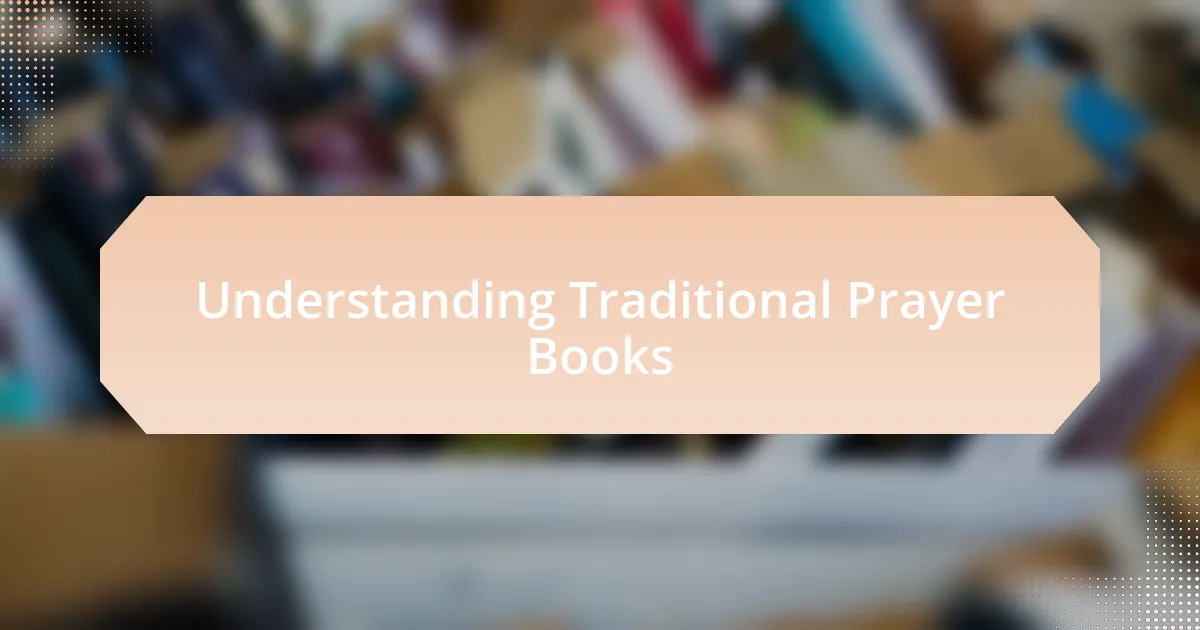
Understanding Traditional Prayer Books
Traditional prayer books serve as a bridge between the sacred and the everyday. I recall the first time I flipped through one; the rich texts, adorned with centuries of spiritual wisdom, immediately filled me with a profound sense of connection and solace. They are not just collections of prayers; they encapsulate the faith and devotion of countless individuals throughout history.
As I delve deeper into their pages, I often find myself reflecting on the rituals surrounding these books. Have you ever noticed how certain prayers resonate with your emotions, capturing your joys and sorrows? This personal connection is what I cherish most. Each prayer has the power to speak to our unique journeys, offering solace in times of distress while elevating moments of gratitude.
Moreover, traditional prayer books encompass a variety of styles and formats, allowing readers to engage with the text in different ways. I remember being intrigued by the beauty of the handwritten manuscripts, each stroke conveying the devotion of the creator. It’s fascinating how these physical forms of prayer can evoke such a rich tapestry of experiences, encouraging us to explore our spirituality more deeply.

Importance of Prayer in Religion
When I think about the importance of prayer in religion, I realize it serves as a vital lifeline for many believers. It’s a practice that invites reflection and fosters a sense of community, connecting us not just with the divine, but also with one another. Have you ever felt that pull to pray during a significant life event, like a wedding or a funeral? Those moments illustrate how prayer can unify experiences and emotions within a shared faith.
On a personal note, I vividly remember a time when prayer became my refuge during a challenging period. The act of praying provided me with clarity and comfort, grounding me in my beliefs. I often wonder how many others have sought solace in the act of prayer—it’s a powerful reminder of the support we find in our faith, especially during turbulent times.
Moreover, the communal aspect of prayer cannot be underestimated. Participating in group prayers has always been a profound experience for me. There’s something incredibly moving about joining voices in collective supplication or gratitude, creating a shared rhythm of hope and faith that transcends individual struggles. Do you feel that same connection when you pray with others, or is it a solitary practice for you? For me, it’s a blend of both—sometimes I find strength in solitude, and other times, in the unity of community.

Features of Traditional Prayer Books
Traditional prayer books often feature structured prayers, hymns, and meditative passages that cater to various occasions and needs. I appreciate how these texts guide us through the cycles of worship, offering words to express our innermost feelings when we sometimes struggle to find them ourselves. Can you recall a moment when you flipped through the pages of a prayer book, searching for the right words to echo your heart’s desire?
Additionally, the physical aspect of traditional prayer books adds a personal touch that digital formats simply can’t replicate. I find comfort in the feel of well-worn pages, often marked with notes or creases from years of use. These tangible elements remind me of the prayers said before a significant event or the quiet moments spent in reflection, all encapsulated in the book’s history. How much do the artifacts of faith—like a prayer book handed down through generations—influence your spiritual journey?
Moreover, many traditional prayer books include commentaries and explanations that enhance understanding. I love flipping to the notes that provide context about a particular prayer or scripture. This deeper insight not only enriches my prayers but also connects me more profoundly to the beliefs and traditions I hold dear. When was the last time you discovered something new that shifted your perspective during prayer?
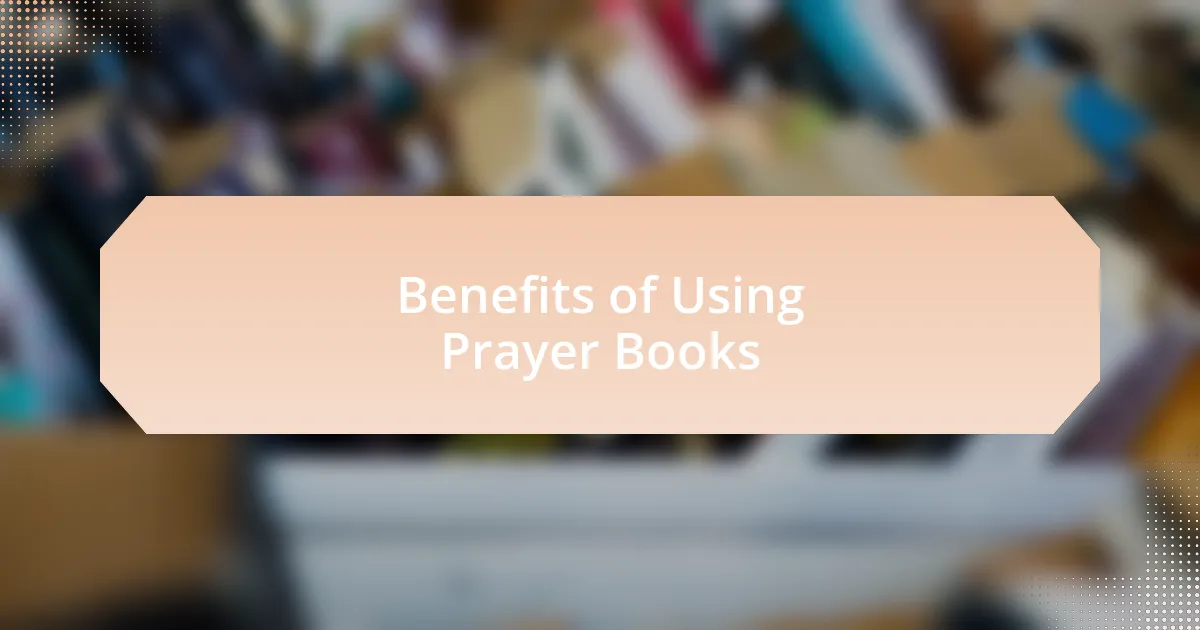
Benefits of Using Prayer Books
Using traditional prayer books can be incredibly grounding for one’s spiritual practice. I’ve experienced moments where the structured layout of prayers has helped to bring a sense of peace during turbulent times. Don’t you find it reassuring to have a reliable framework that allows you to focus entirely on your thoughts and feelings without distraction?
Furthermore, the communal aspect of prayer books is often overlooked. I remember attending a service where everyone held the same prayer book, creating a powerful sense of unity. It was enlightening to see how collective recitation could elevate the spiritual experience, weaving our intentions together. Have you ever felt that shared energy among a group, enhancing the sanctity of the moment?
Lastly, the repetition of prayers found in these books can be quite transformative. In my personal journey, I’ve found that consistent recitation helps me internalize the meanings behind the words. This practice can deepen one’s connection to faith and create a rich tapestry of understanding through daily reflections. How has repetition shaped your experience of prayer and reflection?
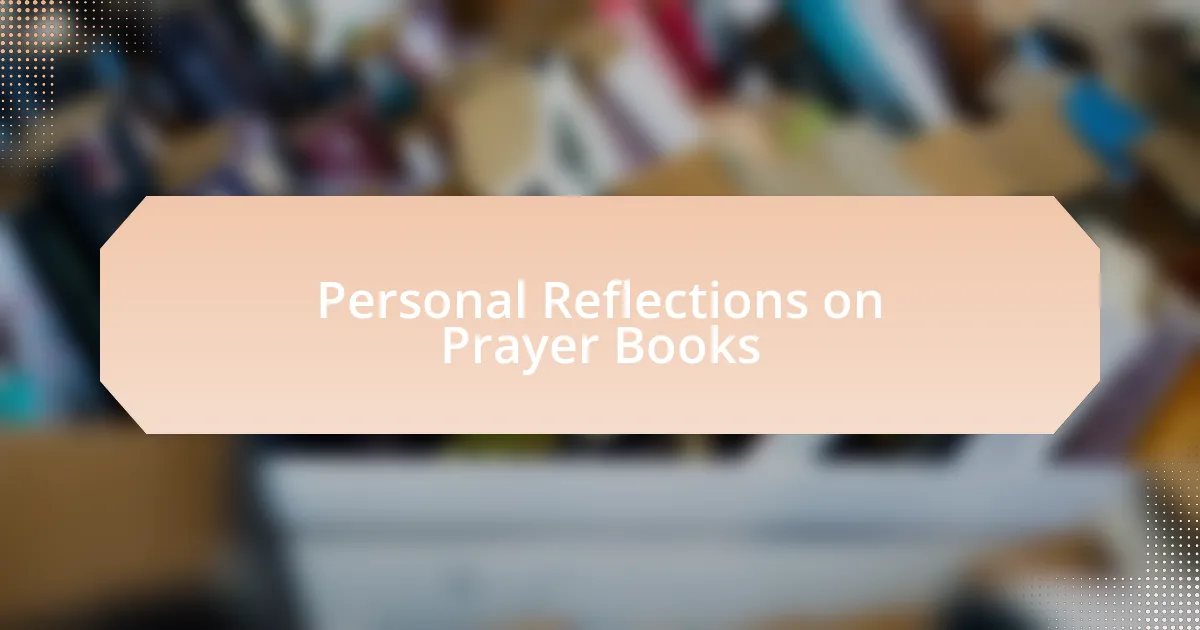
Personal Reflections on Prayer Books
There’s something truly special about the tactile experience of a prayer book; the feel of the pages and the smell of the paper can evoke a sense of nostalgia. I recall flipping through the worn pages of a family prayer book, the margins filled with annotations and notes from generations before me. Does that connection to history resonate with you as it does with me? It’s like holding a piece of my spiritual heritage in my hands.
When I engage with a prayer book, I often find my mind drifting into contemplation, allowing the words to wash over me. One evening, while praying a simple evening litany, I lost track of time; each utterance felt like a moment of intimate dialogue with the Divine. Have you experienced that blissful state where prayer becomes less about the words and more about the connection to something greater?
Beyond the words themselves, the illustrations and sacred art often found in prayer books can enhance the meditation experience. I remember being captivated by a beautifully illuminated text that brought the prayers to life visually. It made me wonder: how can imagery transform our understanding of faith and invite us deeper into contemplation?
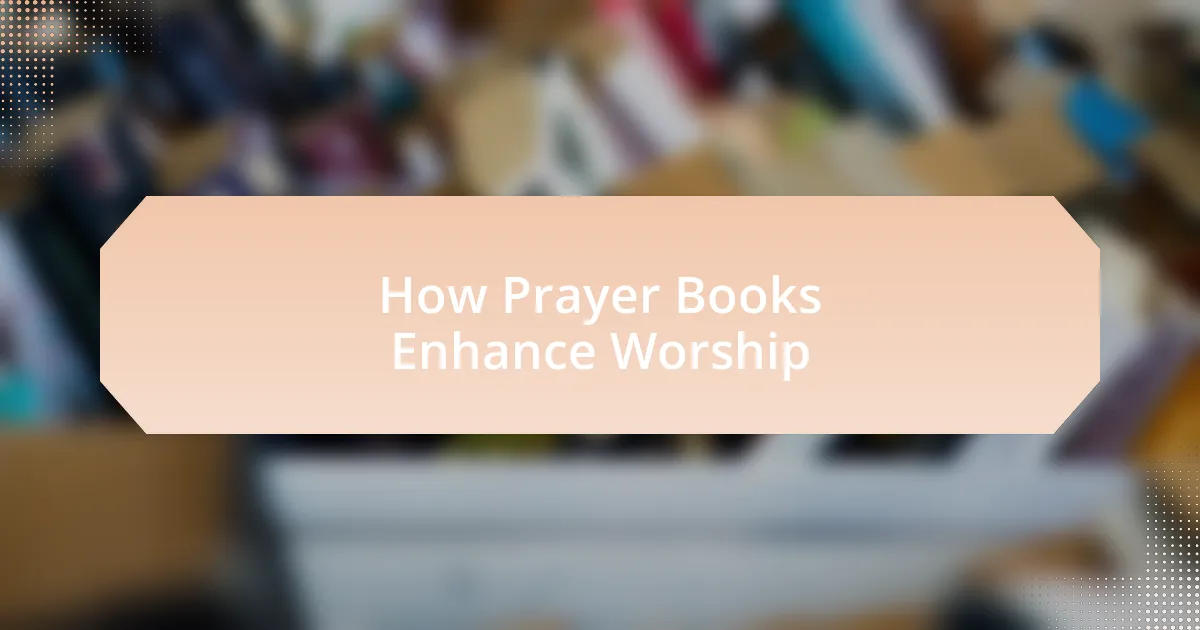
How Prayer Books Enhance Worship
There are moments during worship when the rhythm of the prayers in a traditional prayer book helps unify my spirit with the community around me. I vividly remember a group gathering where we recited a familiar prayer together, and it felt as if our voices were woven into a single tapestry of faith. Have you ever felt that communal strength surge during group prayer? It’s a reminder of how prayer books can draw us closer to one another.
Using a prayer book often helps me focus my thoughts, especially on days when distractions abound. Just last week, I opened a prayer book in a quiet corner of my home, and the structure of the liturgy provided a welcome anchor for my wandering mind. The organized flow of prayers offered exactly what I needed to dive deeper into my connection with the divine. Don’t you find that sometimes all we need are those gentle cues to guide us back into meaningful reflection?
The language of many prayer books, rich with historical significance, also fosters a sense of continuity with the past. I still recall the first time I encountered a prayer penned centuries ago; every phrase felt charged with the weight of countless believers who had recited it before me. How remarkable is it to consider that these words have echoed in places of worship around the world for generations? There’s a powerful reassurance in knowing that shared languages of faith can transcend time and space.
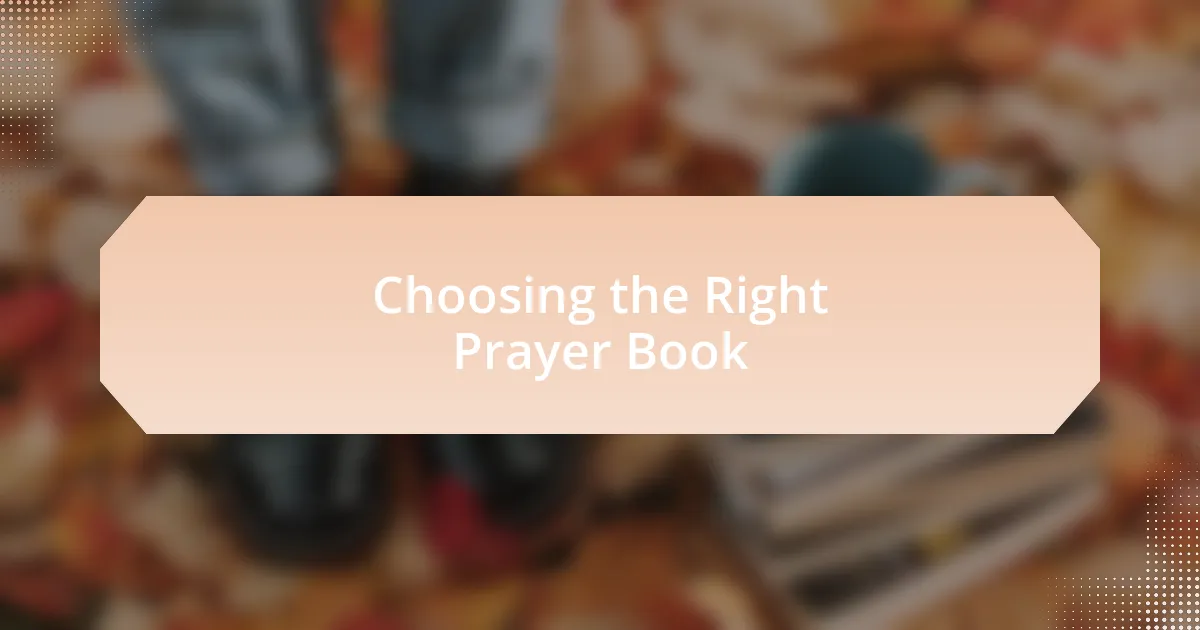
Choosing the Right Prayer Book
Choosing the right prayer book can feel like a personal journey. When I started exploring various options, I found myself gravitating toward those that resonated with my background and beliefs. Have you ever picked up a book and felt an immediate connection? It’s essential to consider not just the content but the emotional resonance it brings to your heart.
Moreover, I’ve learned that the edition matters just as much. A beautifully bound prayer book with thoughtful illustrations can enhance the experience. I recall the joy I felt when I discovered a leather-bound volume with gold-edged pages—it made each prayer feel even more special. How could something so simple elevate the act of worship? It’s all in the details.
Additionally, take into account how easy it is to navigate the book. I once struggled with a complex layout that made it challenging to participate during services. Finding a prayer book with clear divisions and intuitive organization allowed me to focus better. Have you found yourself lost in an unfamiliar structure? Simplifying that accessibility can truly deepen your worship experience.